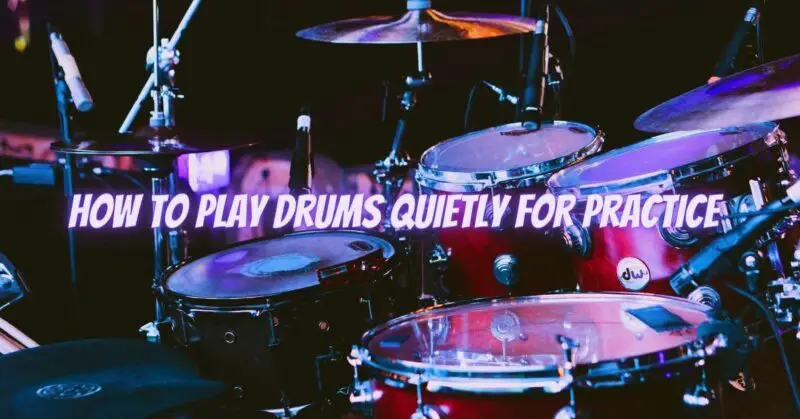Practicing drums at lower volumes is essential for maintaining good relationships with neighbors, respecting noise restrictions, and practicing during late hours. While playing quietly may seem challenging, it offers an opportunity to develop control, finesse, and a heightened sense of dynamics. In this article, we will explore effective techniques and strategies for playing drums quietly during practice sessions.
- Practice Pad and Drum Mutes: a. Utilize a practice pad: Start by practicing rudiments, hand techniques, and stick control exercises on a practice pad. This allows you to refine your technique and build muscle memory without generating excessive noise. b. Invest in drum mutes: Use drum mutes or silencer pads placed on drumheads and cymbals to reduce volume while practicing on your drum set. These rubber or foam-based pads absorb the impact and dampen the sound, making your drums quieter without sacrificing feel or responsiveness.
- Stick Control and Technique: a. Focus on finger control: Develop finger control by utilizing finger-based strokes, such as finger control exercises or finger rolls on a practice pad. This allows you to practice drumming technique with minimal volume. b. Practice rebound control: Work on controlling the stick rebound by adjusting your grip and stroke technique. Experiment with lighter strokes and utilizing the natural rebound of the drumstick to reduce volume while maintaining control.
- Hot Rods and Brushes: a. Use Hot Rods or Blasticks: Hot Rods, consisting of bundles of dowels, and Blasticks, which feature thin, flexible rods, are alternative drumsticks that produce reduced volume while still allowing you to play on your drum set. These tools create a softer, more delicate sound by spreading the impact across multiple thin sticks. b. Brushes: Explore the use of brushes for practicing on your drum set. Brushes provide a quieter and more delicate sound, allowing you to focus on brush technique, subtlety, and dynamic control.
- Drum Dampening: a. Drumhead dampening: Apply dampening materials to your drumheads to reduce volume and sustain. Products like gel pads, adhesive dampening gels, or specially designed drumhead rings can be placed on the drumheads to control overtones and volume. b. Bass drum muffling: Use a bass drum pillow or blanket placed inside the drum to reduce volume and sustain. This muffles the drum’s sound, resulting in a quieter and more controlled bass drum sound.
- Cymbal Management: a. Choose low-volume cymbals: Consider investing in low-volume cymbals specifically designed for quiet playing. These cymbals are crafted with special alloys or perforations to reduce volume while retaining the characteristic feel and response of regular cymbals. b. Muffle cymbals: Place cymbal felts or dampening pads on top of your cymbals to reduce their volume and sustain. This helps to control the overall volume and sustain of the cymbals while practicing.
- Electronic Drum Kit: a. Consider an electronic drum kit: If reducing volume is a consistent concern, investing in an electronic drum kit can provide an ideal solution. Electronic drum kits allow you to practice silently with headphones, offering authentic drumming experience while eliminating excessive noise.
- Dynamic Control: a. Focus on dynamics: Concentrate on developing a wide range of dynamics in your playing. Practice playing at different volume levels, ranging from very soft to moderately loud. This exercise will improve your dynamic control and help you adapt your playing style to quieter environments.
- Time Management: a. Plan practice sessions: Coordinate your practice sessions to align with acceptable noise levels, such as during daytime hours or when neighbors are less likely to be disturbed. Communicate with those around you to find mutually convenient practice times.
Conclusion: Practicing drums quietly is not only essential for maintaining peace with neighbors but also provides an opportunity to enhance control, finesse, and dynamics in your playing. By incorporating techniques such as practicing on a pad, utilizing drum mutes, focusing on stick control and technique, using alternative tools like Hot Rods and brushes, applying drum dampening, managing cymbal volume, considering an electronic drum kit, emphasizing dynamic control, and managing practice times effectively, you can continue to develop your drumming skills while keeping the volume at an acceptable level. Remember, practicing quietly does not mean compromising your technique or musicality—it presents a unique chance to refine your playing and explore nuances that can take your drumming to new heights.


